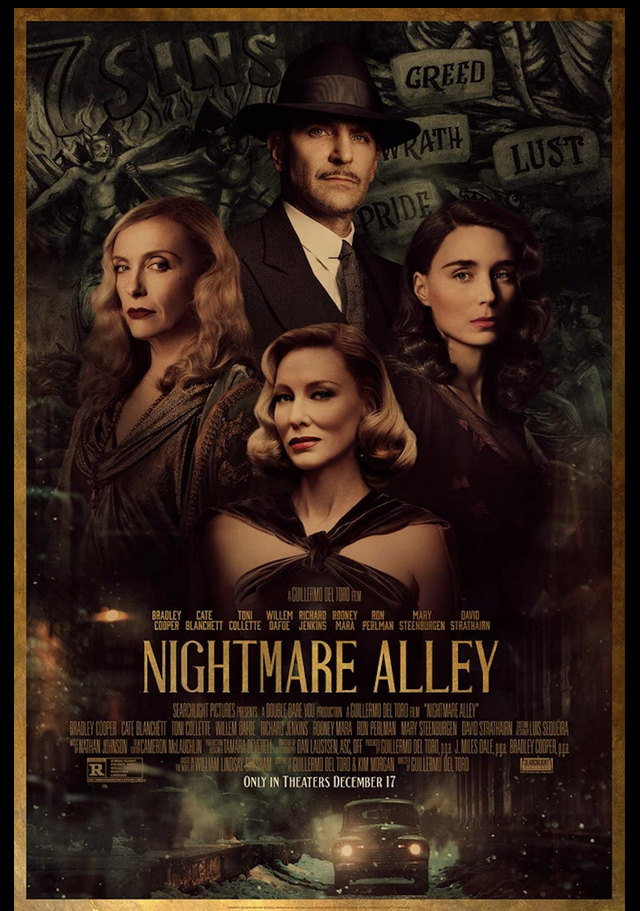
Nightmare Alley is a film that this year, on the occasion of the Oscars, received 4 nominations for the golden statuette. However, it failed to win any award.
Directed by Benicio del Toro and with a homogeneous cast, a so-called "ensemble cast", that is to say, a cast in which the main actors and characters are assigned approximately the same importance in a movie, it is an excellent psychological noir thriller of the year 2021.
The main actors include Bradley Cooper, Cate Blanchett, David Strathairn, Richard Jenkins, Ron Perlman, Rooney Mara, Toni Collette and Willem Dafoe,
It is difficult to accept why he did not receive any award.
This is the circumstance that has led me to inaugurate this series of film reviews dedicated to films that have been very well received by critics and the general public. And yet, when the time came to pick up, to pick up some golden statuette from Hollywood, they were left empty-handed.
It will not be the first nor the last that has had to go through these vicissitudes of the jury, which does not detract from the merits of the product as such.
The fact that it is a remake of the original may have contributed to this. As is well known, the Hollywood Academy has (almost) always preferred the originality of the film products presented, if possible, without previous versions.
Shortly after the release of the original novel, the rights were acquired by 20th Century Fox to make a film starring Tyrone Power, Joan Blondell, Coleen Gray and Helen Walker, among other actors. At that time, Power was somewhat tired of always being framed in the romantic and swashbuckling roles that brought him fame, so he had willingly accepted the script that had been presented to him.
At that time, it was unusual for a top-level figure like Power to play in a film of the so-called "police film noir" and perhaps for that reason, although it was not a failure, it was far from being a success according to the budget used.
Due to the COVID-19 pandemic, the film suffered several delays, both in its own filming and photographic editing. It was finally released in the U.S. in mid-December 2021.
Having made these clarifications, let's move on to the review of Nightmare Alley.
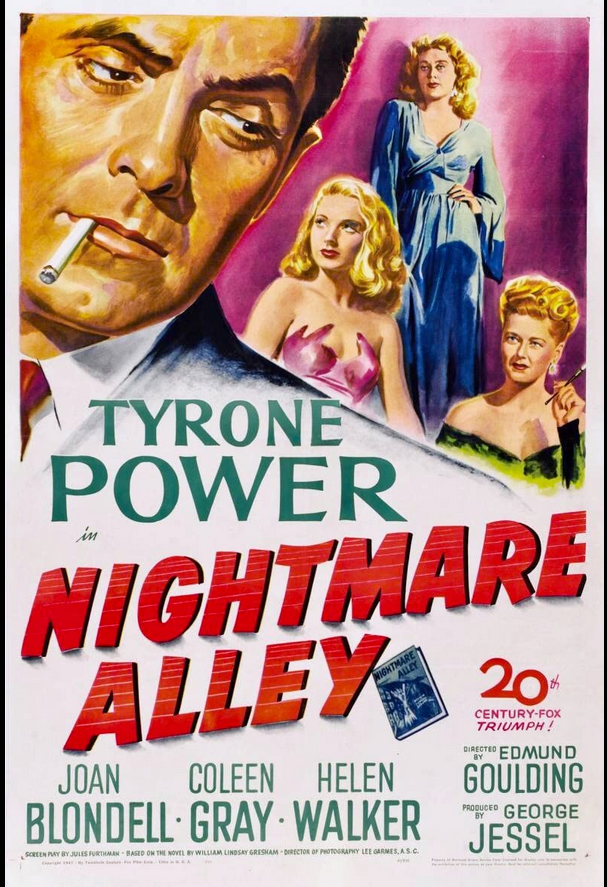
El Callejón de las Almas Perdidas (Nightmare Alley en el título original en inglés) es una película que este año, en oportunidad del otorgamiento de los Óscar, recibió 4 nominaciones a la estatuilla dorada. Sin embargo no pudo vencer ningún premio.
Dirigida por Benicio del Toro y con un reparto homogéneo, de los llamados en la jerga cinematográfica, reparto coral, es decir, un reparto en el que los principales intérpretes y personajes tienen asignada aproximadamente la misma importancia en una pelicula, es una excelente película de suspenso psicológico noir del año 2021.
Entre los principales actores se destacan Bradley Cooper, Cate Blanchett, David Strathairn, Richard Jenkins, Ron Perlman, Rooney Mara, Toni Collette y Willem Dafoe,
Que resulta difícil de aceptar por qué motivo no recibió ningún premio.
Esta ha sido la circunstancia que me ha llevado a inaugurar esta serie de reseñas cinematográficas dedicadas a películas muy bien recibidas por la crítica y el público en general. Y que, sin embargo, a la hora de recoger, de recoger alguna estatuilla dorada de Hollywood, se han quedado con las manos vacías.
No será la prima ni tampoco la última que ha debido pasar por estos avatares del jurado, lo cual tampoco quita, méritos al producto como tal.
El hecho de ser un remake del original puede haber contribuido a ello. Como es sabido, la Academia de Hollywood ha preferido (casi) siempre la originalidad de los productos cinematográficos presentados, si es posible, sin versiones previas.
Poco después de la salida de la novela original fueron adquiridos los derechos por la 20th Century Fox para hacer una pelicula protagonizada por Tyrone Power, Joan Blondell, Coleen Gray y Helen Walker, entre otros actores. En ese momento Power, estaba algo cansado de ser encuadrado siempre en los roles románticos y de espadachín que lo llevaron a la fama, por lo cual había aceptado de buena voluntad el guion que le habian presentado.
En ese momento no era usual que una figura de primer nivel como Power interpretara una pelicula del llamado "cine policial negro" y tal vez por ese motivo, si bien no fue un fracaso, estuvo lejos de ser un éxito de acuerdo al presupuesto utilizado.
Debido a la pandemia del COVID-19, la pelicula sufrió varias demoras, ya sea en su faz de filmación propia y dicha como en el montaje fotográfico. Finalmente fue estrenada en los EE. UU. a mediados de diciembre de 2021.
Hechas estas aclaraciones pasemos a la reseña de El callejón de las almas perdidas.

The plot begins with a particularly strange scene whose meaning we will discover only towards the end of the film.
A man burns his house in the American Midwest, a farm totally isolated from any population and without even a tree around, after having dug a hole in the wooden pavement and having buried a person.
He gathers his things and sets off in search of new horizons. On his way he discovers a traveling amusement park trailer that takes him along and offers him a job.
Stanton "Stan" Carlisle begins to work doing menial tasks and discovers that the main attraction is the beast man, a person deprived of any sign of humanity.
When, due to mistreatment, this poor character is left at the end of his life, Stan helps Clem, the owner, to leave him abandoned at the doors of a drugstore when a torrential rain lashes down.
When Stan asks Clem, the owner of the amusement park, to explain how the so-called "beast man" has been reduced to this state, Clem confesses a little secret.
In reality they are people absolutely abandoned by their families, friends and society itself who are getting more and more intoxicated every day consuming drugs and alcohol. He picks them up promising them a job. But in reality he continues to drug them until they become "beast men", the main source of attraction in his shows. He even shows him where the liquor used to drug them is kept next to bottles of toxic methanol used in other shows.
The idea disgusts Stan who begins to discover strange paranormal gifts in himself that make him intuit certain behaviors in some situations.
For example, when the police try to raid the park on the grounds of inhumane treatment and lack of ethics, morals and good manners.
He manages to convince the police inspector of the contrary and avoid the closing of the amusement park, gaining the owner's esteem.
He also contributes to make more effective and realistic the spectacle of a woman who "apparently" dies electrocuted in a chair.
In reality, he gradually discovers that the mentalistic games are a scam, since Madame Zeena, the fortune teller, uses a coded system of language to make the public believe that she possesses extraordinary mental powers. She is supported by her elderly husband Pete, who cannot hide his weakness for drinking.
One night, on the sly, he asks Stan to provide him with a drink behind his wife's back. Accidentally or not, the interpretation is up to the spectator, Stan gives him a bottle of methanol to drink instead of the normal liquor and the old illusionist dies.
To avoid suspicion and reprisals Stan, who is becoming more and more skilled at the mind game, together with his colleague Molly leave the park to start freelancing.
The plot moves forward two years and shows an affirmed illusionist Stan with his assistant Molly who has managed to perfect the teachings of Madame Zeena and works for a wealthy elite citizen in the city of Buffalo.
His fame arouses envy and suspicion. One night a woman (psychologist Lilith Ritter) tries to make a fool of him by asking him to guess what's in her purse.
Stan, who always acts blindfolded, has a trick for emergency situations. It consists of pretending to feel bad, pulling down the blindfold, looking around him and in this case at the woman's purse a couple of meters away), covering his eyes again and trying to guess by taking advantage of the real gifts he possesses.
In this way, she tells him that she has a small revolver in her purse to the astonishment of all those present, who confirm and applaud.
When the psychologist asks him to explain how he guessed, because she knows it is a fake, Stan explains the procedure and clarifies that he had seen a heavy object inside his bag that made him lean to a certain side.
Shortly thereafter Stan is contacted by Judge Kimball who tries to contact his only deceased son through his wife. But first he has contacted psychologist Ritter to find out if Stan is a con man or if he is really a medium.
From that moment on, a certain collaboration between the two begins, although neither trusts the other. The psychologist reveals aspects of the judge's life to Stan to affirm his trust and in return she puts him through therapy sessions where she probes Stan's feelings of guilt. About life with his alcoholic father (in a flashback we discover that he is the person Stan has left to freeze to death in the cabin in the cabin, buried and then burned).
Along with Kimball, the big clients start coming in and with them the money. Stan tries to seize a couple of rich clients and then go off to enjoy his fortune. Molly advises him to drop everything and retire to live in peace.
The new rich client who will mark the beginning of the end is Ezra Grindle, another rich and powerful socialite. Eaten up with guilt for having caused the death of his mistress, he hires him to contact her and ask for her forgiveness.
However, everything goes wrong. Molly, who had reluctantly helped him in this last "interpretation" impersonating Dory, the deceased lover, fails to avoid Grindle's physical contact with her (in reality the "ghost" had to appear from afar, unreachable for the rich businessman who had paid without limits for this session).
With the physical contact Grindle realizes the deception, becomes enraged, and is killed with a cane blows by Stan himself in an act of madness and violence in fear of being discovered.
Molly, upon discovering Stan's true personality, flees for good. The only refuge left is the psychologist's studio, but she discovers that she has always cheated him by keeping his money and denouncing him to the police who are arriving.
In a last act of revenge he tries to kill the woman, but the arrival of the police prevents it. He flees without a fixed goal, wounded and wanted by the police all over the state, he discovers that there is an amusement park in the area.
When he arrives he discovers that it is the same park that hosted him years ago, only that the owner has changed. Clem has retired and sold it to a new owner who rejects Stan's mentalist skills when Stan shows up looking for work.
In fact, he tells him when Stan turns to leave, there is a job that continues to arouse the curiosity of the viewers, it is only temporary and he does not know if it would be to his liking: it is the "beast man".
Abandoning all traces of humanity and dignity, laughing and sobbing, and knowing the future that awaits him, Stan accepts the job offer.

La trama inicia con una escena particularmente extraña cuyo significado descubriremos solo hacia el final de la película.
Un hombre quema su casa en el Midwest americano, una granja totalmente aislada de cualquier población y sin siquiera un árbol alrededor, luego de haber excavado un hoyo en el pavimento de madera y haber enterrado una persona.
Recoge sus cosas y se encamina buscando nuevos horizontes. En su caminar descubre una caravana de un parque de diversiones itinerante que lo lleva consigo y le ofrece un trabajo.
Stanton "Stan" Carlisle comienza a trabajar haciendo tareas menores y descubre que la atracción principal es el hombre bestia, una persona privada de cualquier signo de humanidad.
Cuando a causa de los malos tratos este pobre personaje queda en fin de vida Stan ayuda a Clem, el dueño, a dejarlo abandonado en las puertas de una farmacia cuando azota una lluvia torrencial.
Cuando Stan le pide explicaciones a Clem, el propietario del parque de diversiones, como se ha reducido en ese estado el llamado "hombre bestia", Clem le confiesa un pequeño secreto.
En realidad son personas absolutamente abandonadas por sus familiares, amigos y la sociedad misma que se embrutecen cada día más consumiendo drogas y alcohol. Él los recoge prometiéndoles un trabajo. Pero en realidad continua a drogarlos hasta convertirlos en "hombres bestias", fuente de atracción principal en sus espectáculos. Le muestra incluso donde está el licor que sirve para drogarlos conservado al lado de botellas de metanol tóxicas usadas en otros espectáculos.
La idea repugna a Stan quien comienza a descubrir extrañas dotes paranormales en sí mismo que lo hacen intuir ciertos comportamientos en algunas situaciones.
Como por ejemplo cuando la policia pretende allanar el parque aduciendo tratos deshumanos y falta de ética, moral y buenas costumbres en los mismos.
Logra convencer al inspector de policia del contrario y evitar el cierre del parque de diversiones ganándose la estima del propietario.
Contribuye asimismo a hacer más efectivo y realista el espectáculo de una mujer que "aparentemente" muere electrocutada en una silla.
En realidad de a poco descubre que los juegos mentalisticos son una estafa, ya que Madame Zeena, la adivina, se sirve de un sistema codificado de lenguaje para hacer creer al público que ella posee poderes mentales extraordinarios. Y para actuarla cuenta con el apoyo de su marido Pete, ya anciano quien no puede ocultar su debilidad por la bebida.
Una noche, a escondidas, le pide a Stan que le procure de beber a escondidas de su mujer. Accidentalmente o no, la interpretación corre por cuenta del espectador, Stan le da de beber una botella de metanol en vez del licor normal y el viejo ilusionista muere.
Para evitar sospechas y represalias Stan, que cada vez ser revela más hábil en el juego mental, junto con su colega Molly dejan el parque para comenzar a trabajar por cuenta propia.
La trama hace un saldo en adelante de dos años y muestra a un Stan ilusionista afirmado con su asistente Molly quien ha logrado perfeccionar las enseñanzas de Madame Zeena y trabaja para una rica elite ciudadana en la ciudad de Búfalo.
Su fama despierta envidias y sospechas. Una noche una mujer (la psicóloga Lilith Ritter) trata de ponerlo en ridículo pidiéndole que adivine que tiene en el bolso.
Stan que siempre actúa con los ojos vendados tiene un truco para las situaciones de emergencia. Consiste en simular sentirse mal, bajarse la venda que le cubre los ojos, mirando alrededor suyo y en este caso el bolso de la mujer a un par de metros suyo) volver a cubrirse los ojos y tratar de adivinar aprovechando las verdaderas dotes que posee.
De esta manera le dice que tiene un pequeño revolver en el bolso ante el estupor de todos los concurrentes que confirman y aplauden.
Cuando la psicóloga le pide que explique como ha hecho para adivinar, porque ella sabe que es una farsa, Stan le explica el procedimiento y le aclara que había visto un objeto pesado dentro de su bolso que lo hacía inclinarse hacia un cierto lado.
Poco después Stan es contactado por el juez Kimball quien trata de contactarse con su único hijo fallecido a través de su mujer. Pero antes ha contactado a la psicóloga Ritter para saber si Stan es un estafador o si verdaderamente es un médium.
Desde ese momento comienza una cierta colaboración entre ambos aunque ninguno se confia. La psicóloga revela a Stan aspectos de la vida del juez para afirmar su confianza y a cambio de ello lo somete a sesiones de terapia donde indaga sobre los sentimientos de culpa que aquejan a Stan. Sobre la vida con su padre alcoholizado (en un flashback descubrimos que es la persona que Stan ha dejado morir de frío en la cabaña en la cabaña, enterrado y después quemado)
Junto a Kimball comienzan a llegar los clientes importantes y con ellos el dinero. Stan trata de incautar a un par de ricos clientes y luego irse a disfrutar de su fortuna. Molly le aconseja de abandonar todo y retirarse a vivir en paz.
El nuevo cliente rico que marcara el inicio del fin se llama Ezra Grindle, otro personaje rico y potente de la alta sociedad. Devorado por el sentido de culpa por haber provocado la muerte de su amante lo contrata para contactarse con ella y pedirle perdón.
Sin embargo todo sale mal. Molly, que a regañadientes lo había ayudado a esta última "interpretación" personificando a Dory, la amante fallecida no logra evitar el contacto físico de Grindle con ella (en realidad el "fantasma" tenía que aparecer de lejos, inalcanzable para el rico empresario que había pagado sin límites por esa sesión).
Con el contacto físico Grindle se da cuenta del engaño, se enfurece, y es asesinado a golpes de bastón por el mismo Stan en un acto de locura y violencia ante el temor de ser descubierto.
Molly al descubrir la verdadera personalidad de Stan huye para siempre. El único refugio que queda es el estudio de la psicóloga, pero descubre que también esta lo ha engañado siempre quedándose con su dinero y denunciándolo a la policia que está llegando.
En un último acto de venganza trata de asesinar a la mujer, pero la llegada de la policia lo impide. Huye sin una meta fija, herido y buscado por la policia de todo el estado descubre que en la zona hay un parque de diversiones.
Al llegar descubre que es el mismo parque que lo hospedara años atrás solo que ha cambiado dueño. Clem se ha retirado y lo ha vendido a un nuevo propietario que rechaza las habilidades mentalistas de Stan cuando este se presenta buscando trabajo.
En realidad, le dice cuando Stan se da vuelta parea irse, hay un trabajo que sigue despertando la curiosidad de los espectadores, es solamente temporáneo y no sabe si seria de su agrado: se trata del "hombre bestia".
Abandonando todo rasgo de humanidad y dignidad, riendo y

Bradley Cooper: Stanton "Stan" Carlisle
Cate Blanchett: Lilith Ritter
Toni Collette: Zeena Krumbein
Willem Dafoe: Clem Hoately
Richard Jenkins: Ezra Grindle
Rooney Mara: Molly
Ron Perlman: Bruno
David Strathairn: Pete Krumbein
Holt McCallany: Anderson
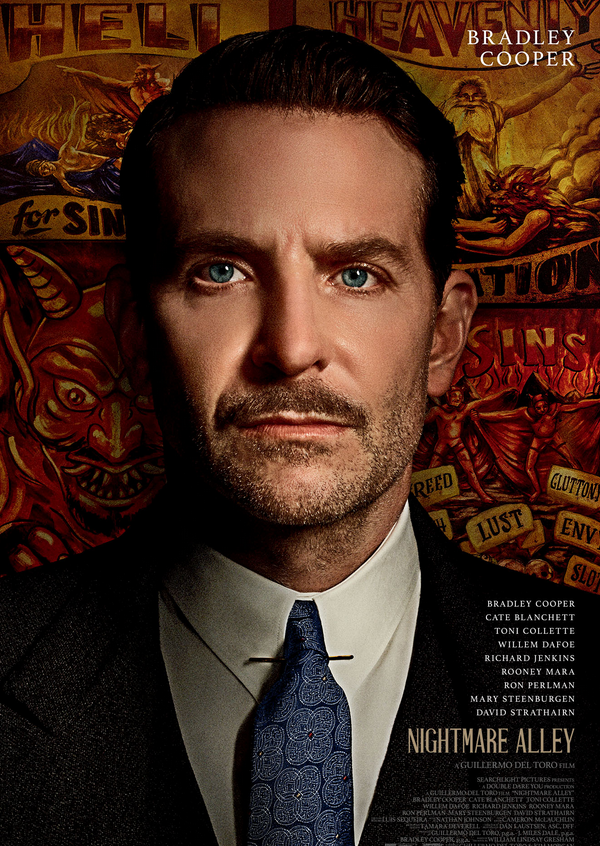
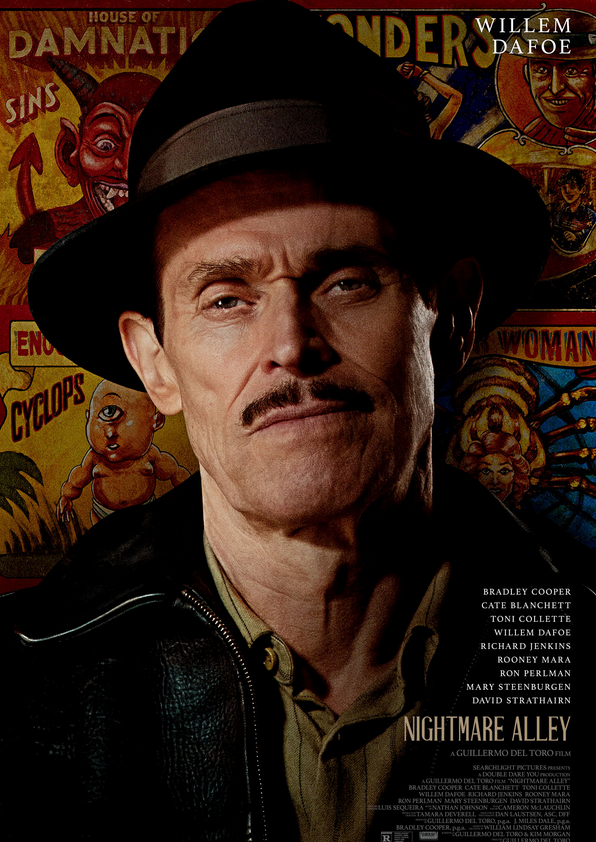

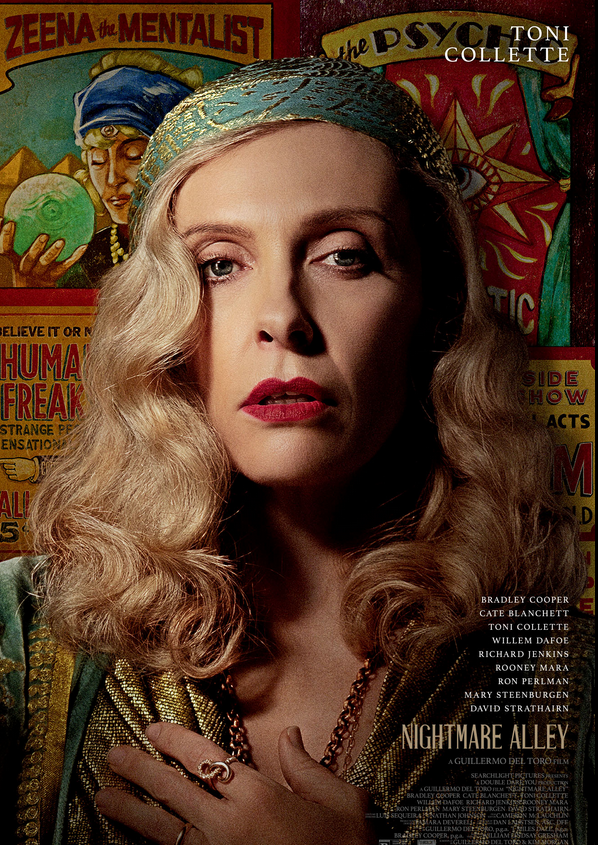
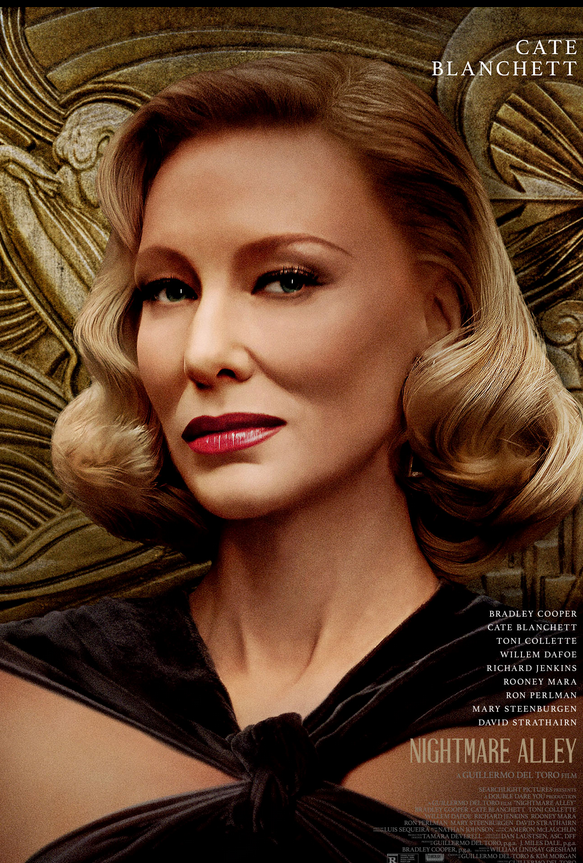


Oscar nominated for Best Picture, Best Cinematography, Best Costume Design and Best Production Design.
Winner of National Board of Review awards for Top 10 Best Picture, San Diego Film Critics Society and San Francisco Bay Area Film Critics Circle for Best Production Design.
It received a total of 52 award nominations and won only three awards.

Nominada al Oscar como Mejor película, Mejor fotografía, Mejor diseño de vestuario y Mejor diseño de producción.
Ganadora de los premios National Board of Review como Top 10 Mejores Películas, del San Diego Film Critics Society y del Círculo de Críticos de Cine del Área de la Bahía de San Francisco como Mejor diseño de producción.
Recibió en total 52 nominaciones a premios y sólo obtuvo tres premios

There are films that it is enough to look at them for a moment to see in which historical moment they are set. The Alley of Lost Souls is one of them. Excellent photographic montage, initially suspended due to the COVID-19 pandemic.
The ending is a masterpiece exposing the main character to his main nightmares: greed, avarice, the selfishness of the human being that transforms him into a real beast.
No less commendable is the flashback where, finally, the viewer finds a sense to the initial image of the film where Stan buries a body in his house and sets fire to it.
The image of the main character walking away amidst the desolation of a landscape, in the middle of the American depression, is of a chilling loneliness while in the background you can see the burning cabin is anthological.
Perhaps it is not a simple curiosity that the author of the novel committed suicide in the same room in which he wrote the book with two cards: in one he explained his terrible personal and economic situation. And on the other he simply said: "I prefer to die rather than face the truth".

Hay películas que es suficiente mirarlas un momento para ver en que momento histórico se sitúan. El Callejón de las Almas Perdidas es una de ellas. Excelente montaje fotográfico, suspendido inicialmente por la pandemia del COVID-19
El final es una obra maestra exponiendo el personaje principal a sus principales pesadillas: la codicia, la avaricia, el egoísmo del ser humano que lo transforma en una verdadera bestia.
No menos encomiable el flashback donde, por fin, el espectador encuentra un sentido a la imagen inicial de la película donde Stan sepulta un cuerpo en su casa y le da fuego a la misma.
La imagen del personaje principal alejándose en medio de la desolación de un paisaje, en plena depresión estadounidense, es de una soledad escalofriante mientras en el fondo se ve la cabaña que arde es de antología.
Tal vez no sea una simple curiosidad el hecho de que el autor de la novela se suicidó en la misma habitacion en la que escribió el libro con dos tarjetas: en una explicaba su pésima situación personal y económica. Y en la otra decía simplemente: "prefiero morir antes que enfrentar la verdad".

The paragraph separator -adapted- is the property of The Peak Studio to whom I am grateful for the kind permission to use it.
El separador de párrafos -adaptado- es propiedad de The Peak Studio a quien agradezco la gentil concesión de uso.


0 Comments:
Publicar un comentario